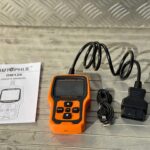Maintaining the health of your vehicle’s transmission is crucial, especially if you frequently tow or haul heavy loads. Overheating is a major concern for transmissions, and by the time your dashboard warning light illuminates, significant damage may already be done. A proactive solution is to monitor your transmission temperature in real-time using an OBD2 scanner and your smartphone. This guide will walk you through how to set up a transmission temp gauge using an OBD2 device.
Why Monitor Transmission Temperature?
Your vehicle’s transmission is a complex system that generates a significant amount of heat during operation. Excessive heat is the enemy of transmission longevity, leading to fluid breakdown, premature wear, and costly repairs. Factory-installed temperature sensors often only trigger a warning light when temperatures reach critical levels, potentially after damage has begun.
For those who tow trailers, caravans, or regularly carry heavy loads, monitoring transmission temperature becomes even more critical. Towing significantly increases the workload on your transmission, leading to higher operating temperatures. By having a real-time transmission temp gauge, you can:
- Prevent Overheating: Catch temperature spikes early and take preventative measures like reducing speed or pulling over to let the transmission cool down.
- Extend Transmission Life: Maintain optimal operating temperatures to prolong the life of your transmission fluid and components.
- Gain Peace of Mind: Drive with confidence knowing you are proactively monitoring a vital aspect of your vehicle’s health.
Setting Up Your OBD2 Transmission Temp Gauge
Turning your smartphone into a transmission temp gauge is easier than you might think. Here’s a step-by-step guide using a generic OBD2 scanner and a compatible app. The process is similar across most vehicles, though specific parameters (PIDs) may vary.
Step 1: Acquire an OBD2 Scanner
The first step is to get an OBD2 (On-Board Diagnostics II) scanner. These devices plug into your car’s OBD2 port, typically located within easy reach of the steering wheel. You can find various OBD2 scanners online or at auto parts stores. Options include Bluetooth or Wi-Fi scanners, which wirelessly connect to your smartphone.
Alt text: Locating the OBD2 port in a vehicle, a rectangular 16-pin connector, usually near the steering wheel for easy access.
Step 2: Choose a Compatible OBD2 App
Next, you’ll need an OBD2 app for your smartphone. Several apps are available for both iOS and Android that can display live vehicle data, including transmission temperature, when paired with an OBD2 scanner. Popular choices include:
- OBD Fusion (Paid): A feature-rich app known for its customization options and support for custom PIDs.
- Torque Pro (Android – Paid): A widely used app with a strong community and extensive plugin support.
- Car Scanner ELM OBD2 (Free/Paid Versions): Offers a good balance of features and user-friendliness, available on both Android and iOS.
While some apps offer free versions, accessing advanced features like custom PIDs for transmission temperature might require a paid upgrade or in-app purchase. Consider your needs and budget when selecting an app.
Step 3: Connect Your OBD2 Scanner and Phone
- Plug in the OBD2 scanner: Locate your vehicle’s OBD2 port and securely plug in the scanner.
- Enable Bluetooth/Wi-Fi: Turn on Bluetooth or Wi-Fi on your smartphone, depending on your OBD2 scanner type.
- Pair Devices: For Bluetooth scanners, search for the device in your phone’s Bluetooth settings and pair. For Wi-Fi scanners, connect to the scanner’s Wi-Fi network. The pairing password, if required, is often “1234” or “0000”.
- Connect via App: Open your chosen OBD2 app and follow its connection instructions to link to the scanner. The app should now be communicating with your vehicle’s computer.
Step 4: Add Transmission Temperature PIDs
OBD2 scanners read data using Parameter IDs (PIDs). Standard OBD2 provides generic data, but transmission temperature often requires custom PIDs specific to your vehicle’s make and model. You’ll need to add these custom PIDs to your OBD2 app.
Alt text: Screenshot of the OBD Fusion app interface showing the settings for adding and configuring custom Parameter IDs (PIDs) for enhanced vehicle data monitoring.
Finding the correct PIDs for your vehicle might require some online research. Here are a few resources:
- Online Forums: Car-specific forums are excellent places to find PIDs shared by other owners. Search for your vehicle’s make, model, and year along with “transmission temperature PID.”
- App Communities: Some OBD2 apps have online communities or databases where users share PIDs.
- Vehicle-Specific Resources: Websites or forums dedicated to your vehicle brand may have PID lists.
Example PIDs for Ford Ranger (2012 onwards):
As an example, for Ford Ranger models from 2012 onwards, you can try these PIDs (use Fahrenheit or Celsius conversion as needed within the app settings):
- PID: 221e1c
- Long Name: Transmission Fluid Temperature (TFT)
- Short Name: TFT
- Min Value: 0.0
- Max Value: 200.0
- Scale: x1
- Unit Type: ºF
- Equation: ((A*256)+B)/8
- Header: 7E1
Important Note: PID compatibility can vary based on vehicle year, model, and ECU type. PIDs found online might not always work perfectly for your specific vehicle. Always verify PID accuracy and consult your app’s documentation or support if you encounter issues.
Step 5: Create Your Custom Dashboard
Once you’ve added the transmission temperature PID, you can create a custom dashboard within your OBD2 app to display this data in real-time. Most apps allow you to choose from various gauge styles and arrange them to your preference. Add your new transmission temperature gauge to your dashboard for easy monitoring.
Alt text: Example of a customized OBD2 app dashboard displaying various real-time vehicle parameters including a prominent transmission temperature gauge for easy monitoring while driving.
Many apps also allow you to set up alerts that trigger when your transmission temperature exceeds a certain threshold. This provides an extra layer of protection and warning against overheating.
Start Monitoring Your Transmission Temperature Today
By following these steps, you can easily set up a transmission temp gauge using an OBD2 scanner and your smartphone. This proactive approach empowers you to monitor your transmission’s health, especially when towing or under heavy load, potentially saving you from costly repairs and extending the life of your vehicle. Take control of your vehicle’s health and enjoy the peace of mind that comes with real-time transmission temperature monitoring.

